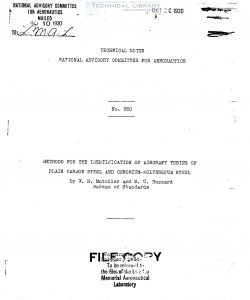naca-tn-350
- Version
- 182 Downloads
- 1.15 MB File Size
- 1 File Count
- November 24, 2016 Create Date
- November 24, 2016 Last Updated
National Advisory Committee for Aeronautics, Technical Notes - Methods for the Identification of Aircraft Tubing of Plain Carbon Steel and Chromium Molybdenum Steel

The increasing use of chromium—molybdenum steel in the
aircraft industry has resulted in the need for a simple method
by means of which it may be accurately and rapidly differenti—
ated from plain carbon steel. A study was accordingly made
which had for its aim a general survey of the possibilities of
a variety of such methods, rather than the development and per—
fection of any specific method. This survey was made by the
authors at the Bureau of Standards and the results obtained
form the basis of the present paper.
Chromium—molybdenum steel, S.A.E. No. 4130K, and plain
carbon steel, S.A.E. No. 1025, are perhaps the two steels most
extensively employed in the manufacture of present—day aircraft.
Both steels are used principally in the form of seamless tubing
for the construction of airplane fuselages. Inasmuch as the
assembling is ordinarily done by welding, the strength of the
tubing in the normalized condition serves as a criterion in de-
steels,'in the normalized condition, have been given by Knerr.
It is evident that there is a considerable difference in I
the tensile properties of the two steels and that, if steel
S.A.E. 1025 were to be used in aircraft construction where the
design called for steel S.A.E. 4130K, the consequences might
prove disastrous. It is imperative, therefore, that this should
not occur, for a single tube so misplaced might give rise to
considerable damage. No danger is to be expected, of course,
if chromium—molybdenum steel were unknowingly substituted in
plane of plain carbon steel.
Opportunities for unintentionally mixing the two steels are
not infrequent. Tubing of both kinds of steel are ordinarily
produced in the same mill, often at the same time. Despite the
greatest care it is virtually impossible to prevent an occasion—
al mixup under conditions of manufacture.
| File | Action |
|---|---|
| naca-tn-350 Methods for the Identification of Aircraft Tubing of Plain Carbon Steel and Chromium Molybdenum Steel.pdf | Download |

Comment On This Post